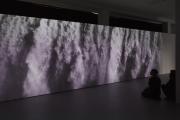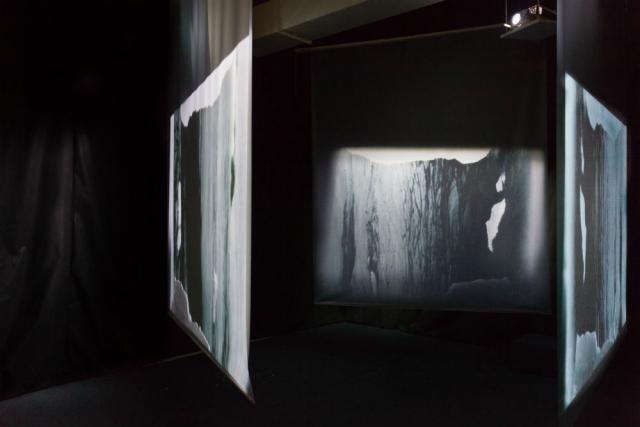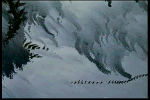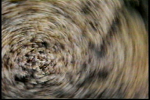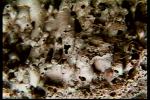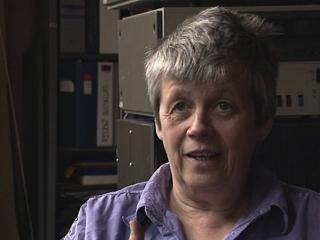Steina
The audiovisual Installation Orka expresses motion, a motion that runs counter to the laws of physics and the “frame-bound image”. The overriding formal orchestration of image events and their relatedness resembles the composition of a visual symphony. Steina describes the roots of her visual thinking, expressed in paradoxical events and free-floating imagery: “Since my art schooling was in music, I do not think of images as stills, but always in motion. My video images primarily hinge upon an undefined sense of time with no earth gravity. It is like a duty to show what cannot be seen except with the eye of media: water flowing uphill or sideways, upside down rolling seas or a weather-beaten drop of a glacier melt.” This approach to expanding perceptual expectations also has an immersive dimension: when the single-channel videotape Orka is set up in a three-channel video environment, the visual material is shown on translucent screens that are equally intense on both sides. “The idea is that perhaps the audience could feel a part of this creative trance, living for a moment in a mental world where they have never been.”Yvonne Spielmann © 2004, FDL
ORKA (Icelandic = "Force") juxtaposes two of the archetypal forces of transformation, water and fire. It is scarcely possible to imagine a more appropriate subject for the artist's contemplation upon the flux of time than the two forces which are virtually synonymous with the unbridled flow of natural energy in Iceland: water and fire, sub-glacial eruptions, glacier bursts cascading over black sands, waterfalls, glacial rivers. Steina has collected video recordings of Iceland on her travels around the country over the past twenty years. She likes to stand with her video camera on bridges, above waterfalls or on top of sheer cliffs, pointing it down into the swirling waters. Her angle of vision is the bird's eye view. Among the simple, but effective camera techniques which she uses are turning the camera upside down, shooting with a moving camera, or using two cameras simultaneously. The fruits of such "video hunting trips" are the raw material which the artist works from in her Santa Fe studio. Almost every single frame in ORKA is manipulated in one way or another, by increasing or decreasing the recording speed, flipping images, shifting colors, changing direction. By playing images in reverse, the artist breaks up the linear progress of time.So time is inherent not only in the subjects of Steina Vasulka's works of video art, but no less in their forms and presentation. One of her main technical characteristics is soft edge keying, which involves creating a rich or soft texture in merging the images, so that it is impossible to say where one ends and another begins. (from the text by Audur Olafsdottir for Venice Biennale, 2000)
In 1965, Steina, an Icelandic musician formally trained as a violinist, emigrated to the United States, arriving in New York City with her husband Woody Vasulka, a Czechoslavakian filmmaker. After purchasing their first Portapak camera and attending the Howard Wise Gallery’s seminal “TV as a Creative Medium” exhibition in 1969, the Vasulkas shot a great deal of footage in public spaces, taping live events and musical performances in concert halls, drag clubs, and Washington Square Park. They began working with sound and images, manipulating the video apparatus with the Rutt/Etra Scan Processor, phase shifters, and modulators. Introducing static, error, delay, and noise into the field of representation, the Vasulkas sought to open up video to unstable states, reflecting both technical exploration and a radical aesthetic critique. Sharing their tapes with friends, along with Nam June Paik and Ira Schneider, in their loft on 14th Street, these sessions served as an informal open studio, which developed into The Kitchen — an experimental electronic media space that opened in 1971 in the kitchen of the Mercer Arts Center’s abandoned and re-outfitted hotel space — where works in progress were shared and live performances took place. Steina now lives and works in Santa Fe, New Mexico. Her work has been shown at the Centre Georges Pompidou, Paris; Museum of Art, Carnegie Institute, Pittsburgh; The Jonson Gallery, University of New Mexico Art Museum, Albuquerque; and the Whitney Museum of American Art, New York.
Epiphany – Frontiers of Solitude
Dům umění Ústí nad Labem September – October 2016 http://duul.ujep.cz/ An exhibition and symposium created within the framework of the international transdisciplinary project Frontiers of Solitude. .. there are many, many other worlds, yes, but they are all hidden within this one. And so to neglect this humble, imperfect, and infinitely mysterious world is to recklessly endanger all the others. Earth in Eclipse-an Essay on the Philosophy of Science and Ethics David Abram …
